 W
WRobert Baker Dairyu Chotan Aitken Rōshi was a Zen teacher in the Harada-Yasutani lineage. He co-founded the Honolulu Diamond Sangha in 1959 together with his wife, Anne Hopkins Aitken. Aitken received Dharma transmission from Koun Yamada in 1985 but decided to live as a layperson. He was a socialist advocating social justice for gays, women and Native Hawaiians throughout his life, and was one of the original founders of the Buddhist Peace Fellowship.
 W
WTenshin Zenki Reb Anderson is a Zen teacher and lineage holder in the Sōtō Zen tradition of Shunryu Suzuki. He is a Senior Dharma teacher at the San Francisco Zen Center and at Green Gulch Farm Zen Center in Marin County, California, where he lives. According to author James Ishmael Ford, "Reb Anderson is one of the most prominent of contemporary Western Zen teachers."
 W
WZentatsu Richard Baker, born Richard Dudley Baker, is an American Soto Zen master, the founder and guiding teacher of Dharma Sangha—which consists of Crestone Mountain Zen Center located in Crestone, Colorado and the Buddhistisches Studienzentrum (Johanneshof) in Germany's Black Forest. As the American Dharma heir to Shunryu Suzuki, Baker assumed abbotship of the San Francisco Zen Center (SFZC) shortly before Suzuki's death in 1971. He remained abbot there until 1984, the year he resigned his position after it was disclosed in the previous year that he and the wife of one of SFZC's benefactors had been having an ongoing affair. Despite the controversy connected with his resignation, Baker was instrumental in helping the San Francisco Zen Center to become one of the most successful Zen institutions in the United States.
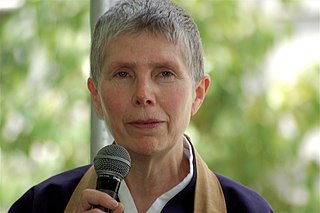 W
WJan Chozen Bays, is a Zen teacher, author, mindful eating educator, and pediatrician specializing in work with abused children.
 W
WSoensanim Bon Yeon is the dharma name and title of Jane McLaughlin-Dobisz. She is the guiding teacher of the Cambridge Zen Center of the Kwan Um School of Zen in Cambridge, Massachusetts. She received dharma transmission in 2000, and is also a published author and editor of the book The Whole World is a Single Flower by Seungsahn.
 W
W"Kainei" Edward Espé Brown is an American Zen teacher and writer. He is the author of The Tassajara Bread Book, written at the Tassajara Zen Mountain Center, as well as other cookbooks that are still influential.
 W
WJohn Hurrell Crook was a British ethologist who filled a pivotal role in British primatology.
 W
WDōgen Zenji, also known as Dōgen Kigen (道元希玄), Eihei Dōgen (永平道元), Kōso Jōyō Daishi (高祖承陽大師), or Busshō Dentō Kokushi (仏性伝東国師), was a Japanese Buddhist priest, writer, poet, philosopher, and founder of the Sōtō school of Zen in Japan.
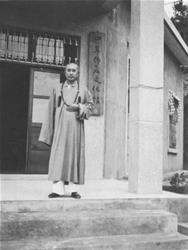 W
WDongchu was a Chinese Ch'an Master in Mainland China and later in Taiwan, and also the teacher of respected modern-day Ch'an Master Sheng-yen. He is the 51st generation of Zen patriarch from the Caodong School. He also established several monasteries and organizations in Taiwan that continue to exist and expand to this very day, including Chung-hwa Institute of Buddhist Culture and Nung Chan Monastery.
 W
WKarl Friedrich Alfred Heinrich Ferdinand Maria Graf Eckbrecht von Dürckheim-Montmartin was a German diplomat, psychotherapist and Zen master. A veteran of World War I, he was introduced to Zen Buddhism early in life. After obtaining a doctorate in psychology, he became an avid supporter of the Nazi Party. Following World War II he was imprisoned in Japan which transformed him spiritually. Upon returning to Germany he became a leading proponent of the Western esoteric spiritual tradition, synthesizing teachings from Christian Mysticism, Depth Psychology and Zen Buddhism.
 W
WZoketsu Norman Fischer is an American poet, writer, and Soto Zen priest, teaching and practicing in the lineage of Shunryu Suzuki. He is a Dharma heir of Sojun Mel Weitsman, from whom he received Dharma transmission in 1988. Fischer served as co-abbot of the San Francisco Zen Center from 1995–2000, after which he founded the Everyday Zen Foundation in 2000, a network of Buddhist practice group and related projects in Canada, the United States and Mexico. Fischer has published more than twenty-five books of poetry and non-fiction, as well as numerous poems, essays and articles in Buddhist magazines and poetry journals.
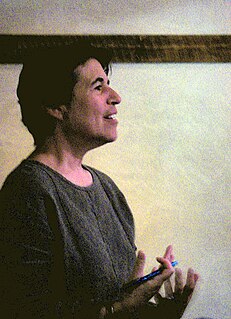 W
WNatalie Goldberg is an American popular author and speaker She is best known for a series of books which explore writing as Zen practice.
 W
WHanshan is a figure associated with a collection of poems from the Chinese Tang Dynasty in the Taoist and Chan tradition. No one knows who he was, when he lived and died, or whether he actually existed. In the Chinese Buddhist tradition, Hanshan and his sidekick Shide are honored as emanations of the bodhisattvas Mañjuśrī and Samantabhadra, respectively. In Japanese and Chinese paintings, Hanshan is often depicted together with Shide or with Fenggan, another monk with legendary attributes.
 W
WShodo Harada , or Harada Rōshi, is a Rinzai priest, author, calligrapher, and head abbot of Sōgen-ji — a three-hundred-year-old temple in Okayama, Japan. He has become known as a "teacher of teachers", with masters from various lineages coming to sit sesshin with him in Japan or during his trips to the United States and Europe.
 W
WHyujeong, also called Seosan Daesa was a Korean Seon master. As was common for monks in this time, he travelled from place to place, living in a succession of monasteries. Buddhist monks had been forced to keep a low profile since General Yi Seonggye had been forced to eject Buddhism from its state of total permeation of government in order to gain the support of Neo-Confucian scholar-officials to consolidate his position against his Buddhist political opponents when he overthrew Gongyang of Goryeo in 1392 to become King Taejo of Joseon.
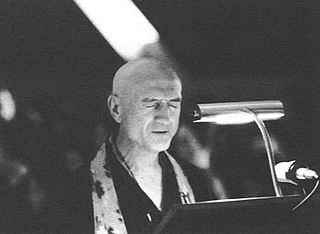 W
WPhilip Kapleau was a teacher of Zen Buddhism in the Sanbo Kyodan tradition, a blending of Japanese Sōtō and Rinzai schools.
 W
WJikai Dainin Katagiri , also known as Hojo-san Katagiri, was a Sōtō Zen roshi and the founding abbot of Minnesota Zen Meditation Center in Minneapolis, Minnesota, where he served from 1972 until his death from cancer in 1990. Before becoming first abbot of the Minnesota Zen Meditation Center, Katagiri had worked at the Zenshuji Soto Zen Mission in Los Angeles and had also been of great service to Shunryu Suzuki at the San Francisco Zen Center, particularly from 1969 until Suzuki's death in 1971. Katagiri was important in helping bring Zen Buddhism from Japan to the United States during its formative years—especially to the American Midwest. He is also the credited author of several books compiled from his talks.
Jakusho Kwong, born William Kwong, is a Chinese-American Zen Buddhist teacher in the lineage of Shunryu Suzuki. He serves as head abbot of Sonoma Mountain Zen Center, of which he is founder. He received the title Dendo Kyoshi from the Soto School of Japan in 1995.
 W
WJohn Daido Loori was a Zen Buddhist rōshi who served as the abbot of Zen Mountain Monastery and was the founder of the Mountains and Rivers Order and CEO of Dharma Communications. Daido Loori received shiho from Taizan Maezumi in 1986 and also received a Dendo Kyoshi certificate formally from the Soto school of Japan in 1994. In 1997, he received dharma transmission in the Harada-Yasutani and Inzan lineages of Rinzai Zen as well. In 1996 he gave dharma transmission to his student Bonnie Myotai Treace, in 1997 to Geoffrey Shugen Arnold, and in 2009 to Konrad Ryushin Marchaj. In addition to his role as a Zen Buddhist priest, Loori was an exhibited photographer and author of more than twenty books.
 W
WHakuyū Taizan Maezumi was a Japanese Zen Buddhist teacher and rōshi, and lineage holder in the Sōtō, Rinzai, and Sanbo Kyodan traditions of Zen. He combined the Rinzai use of kōans and the Sōtō emphasis on shikantaza in his teachings, influenced by his years studying under Hakuun Yasutani in Sanbo Kyodan. He founded or co-founded several institutions and practice centers, including the Zen Center of Los Angeles, White Plum Asanga, Yokoji Zen Mountain Center and the Zen Mountain Monastery.
 W
WDennis Merzel is an American Zen and spirituality teacher, also known as Genpo Merzel.
 W
WVen. Myokyo-ni was a Rinzai Zen Buddhist nun and head of the Zen Centre in London.
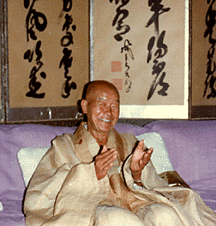 W
WSōen Nakagawa was a Taiwanese-born Japanese rōshi and Zen Buddhist master in the Rinzai tradition. An enigmatic figure, Nakagawa had a major impact on Zen as it was practiced in the 20th century, both in Japan and abroad.
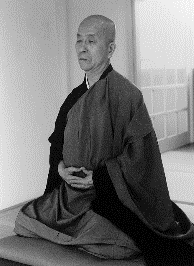 W
WGudo Wafu Nishijima was a Japanese Zen Buddhist priest and teacher.
 W
WSeungsahn Haengwon, born Duk-In Lee, was a Korean Seon master of the Jogye Order and founder of the international Kwan Um School of Zen. He was the seventy-eighth Patriarch in his lineage. As one of the early Korean Zen masters to settle in the United States, he opened many temples and practice groups across the globe. He was known for his charismatic style and direct presentation of Zen, which was well tailored for the Western audience.
 W
WSheng Yen, born Zhang Baokang, was a Chinese Buddhist monk, a religious scholar, and one of the mainstream teachers of Chan Buddhism. He was a 57th generational dharma heir of Linji Yixuan in the Linji school and a third-generation dharma heir of Hsu Yun. In the Caodong lineage, Sheng Yen was a 52nd-generation Dharma heir of Dongshan Liangjie (807-869), and a direct Dharma heir of Dongchu (1908–1977).
 W
WSokei-an Shigetsu Sasaki, born Yeita Sasaki, was a Japanese Rinzai monk who founded the Buddhist Society of America in New York City in 1930. Influential in the growth of Zen Buddhism in the United States, Sokei-an was one of the first Japanese masters to live and teach in America. In 1944 he married American Ruth Fuller Everett. He died in May 1945 without leaving behind a Dharma heir. One of his better known students was Alan Watts, who studied under him briefly. Watts was a student of Sokei-an in the late 1930s.
 W
WDaisetsu Teitaro Suzuki was a Japanese author of books and essays on Buddhism, Zen (Chan) and Shin that were instrumental in spreading interest in both Zen and Shin to the West. Suzuki was also a prolific translator of Chinese, Japanese, and Sanskrit literature. Suzuki spent several lengthy stretches teaching or lecturing at Western universities, and devoted many years to a professorship at Ōtani University, a Japanese Buddhist school.
 W
WShunryu Suzuki was a Sōtō Zen monk and teacher who helped popularize Zen Buddhism in the United States, and is renowned for founding the first Zen Buddhist monastery outside Asia. Suzuki founded San Francisco Zen Center which, along with its affiliate temples, comprises one of the most influential Zen organizations in the United States. A book of his teachings, Zen Mind, Beginner's Mind, is one of the most popular books on Zen and Buddhism in the West.
 W
WKazuaki Tanahashi is an accomplished Japanese calligrapher, Zen teacher, author and translator of Buddhist texts from Japanese and Chinese to English, most notably works by Dogen. He first met Shunryu Suzuki in 1964, and upon reading Suzuki's book Zen Mind, Beginner's Mind he stated, "I could see it's Shobogenzo in a very plain, simple language." He has helped notable Zen teachers author books on Zen Buddhism, such as John Daido Loori. A fellow of the World Academy of Art and Science—Tanahashi is also an environmentalist and peaceworker.
 W
WBrad Warner is an American Sōtō Zen monk, author, blogger, documentarian and punk rock bass guitarist.
 W
WJan Willem Lincoln "Janwillem" van de Wetering was the author of a number of works in English and Dutch.
 W
WWu Kwang Soen Sa Nim (1950–present), born Richard Shrobe, is head Zen teacher at Chogye International Zen Center of New York, a practice center of the Kwan Um School of Zen. Before coming to Zen practice Richard studied Hinduism under Swami Satchidananda. He is a social worker who incorporates Gestalt therapy in his counseling. In 1975 Wu Kwang began his Zen practice and received Dharma transmission from Seung Sahn in 1993. He is also a jazz musician.
 W
WSamyeongdang (1544–1610), also known by his dharma name Yujeong, was a Korean Buddhist monk during the Joseon era. He is sometimes identified by his pen name, Song-un. He was born to a family of the Im clan in Miryang, Gyeongsang Province. After the deaths of his mother in 1558 and his father in 1559, he became a monk at Jikjisa on Hwangaksan in Gimcheon.